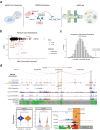MethNet: a robust approach to identify regulatory hubs and their distal targets from cancer data
- PMID: 39025865
- PMCID: PMC11258126
- DOI: 10.1038/s41467-024-50380-3
MethNet: a robust approach to identify regulatory hubs and their distal targets from cancer data
Abstract
Aberrations in the capacity of DNA/chromatin modifiers and transcription factors to bind non-coding regions can lead to changes in gene regulation and impact disease phenotypes. However, identifying distal regulatory elements and connecting them with their target genes remains challenging. Here, we present MethNet, a pipeline that integrates large-scale DNA methylation and gene expression data across multiple cancers, to uncover cis regulatory elements (CREs) in a 1 Mb region around every promoter in the genome. MethNet identifies clusters of highly ranked CREs, referred to as 'hubs', which contribute to the regulation of multiple genes and significantly affect patient survival. Promoter-capture Hi-C confirmed that highly ranked associations involve physical interactions between CREs and their gene targets, and CRISPR interference based single-cell RNA Perturb-seq validated the functional impact of CREs. Thus, MethNet-identified CREs represent a valuable resource for unraveling complex mechanisms underlying gene expression, and for prioritizing the verification of predicted non-coding disease hotspots.
© 2024. The Author(s).
Conflict of interest statement
Aristotelis Tsirigos is a scientific advisor to Intelligencia AI. The rest of the authors declare no competing interests.
Figures







Update of
-
MethNet: a robust approach to identify regulatory hubs and their distal targets in cancer.Res Sq [Preprint]. 2023 Jul 31:rs.3.rs-3150386. doi: 10.21203/rs.3.rs-3150386/v1. Res Sq. 2023. Update in: Nat Commun. 2024 Jul 17;15(1):6027. doi: 10.1038/s41467-024-50380-3. PMID: 37577603 Free PMC article. Updated. Preprint.
References
MeSH terms
Substances
Grants and funding
- P30 CA016087/CA/NCI NIH HHS/United States
- 2R35GM122515/U.S. Department of Health & Human Services | NIH | National Institute of General Medical Sciences (NIGMS)
- R01 CA252239/CA/NCI NIH HHS/United States
- P30CA016087/U.S. Department of Health & Human Services | NIH | National Cancer Institute (NCI)
- R01CA140729/U.S. Department of Health & Human Services | NIH | National Cancer Institute (NCI)
- R01CA252239/U.S. Department of Health & Human Services | NIH | National Cancer Institute (NCI)
- P01 CA229086/CA/NCI NIH HHS/United States
- P01CA229086/U.S. Department of Health & Human Services | NIH | National Cancer Institute (NCI)
- R01 CA140729/CA/NCI NIH HHS/United States
- R35 GM122515/GM/NIGMS NIH HHS/United States
LinkOut - more resources
Full Text Sources
Medical
Molecular Biology Databases
Miscellaneous

